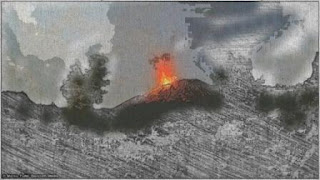In August 1945, a couple of atomic bombs were dropped in Hiroshima and Nagasaki caused a half million people killed and promptly ended World War II. However, hardly anybody was aware that a much stronger explosion, around 30,000 times than the said atomic bombs, blasted from the Krakatoa volcano sixty years earlier.
As high as 40 meters of tsunami waves caused by the eruption swept away everything around without mercy. A big steamship harboring at Anyer, the coast of West Java, was thrown away 3 kilometers inland. The explosion was heard to faraway lands at a radius of 5,000 kilometers from the eruption. Around 36,000 people perished.
The global impact was staggering. Around 100 billion tons of materials were projected into the atmosphere up to 80 kilometers altitude. The stratosphere was covered by the ash of the volcano and only a slight amount of sun rays capable to reach the earth causing Europe missed its summers for 3 consecutive years.
The historical record indicates that much bigger eruption of Krakatoa took place in 535 CE, as pointed out in the Javanese King’s Chronicle, caused a huge flood propagated eastward and destroyed the whole area of Sunda Strait. A gigantic storm and rain of volcanic ashes darken the whole area for a long time.
In the other part of the world, a Syrian bishop in Ephesus reported in the same year: “The sun stops signing well for 18 months and the weather becomes extremely cold. We are afraid the sun will never shine as usual again. Many people die because of the coldness and of the bubonic plague following the eruption.” Other documents from the Ming Dynasty in China pointed out: “The extremely loud sound of the explosion is heard from thousand miles away.”
Those documents matched with the finding of enormous sulfuric deposits frozen deep inside the ice block of Greenland and Antarctica which was dated to around 500 CE. It was the remnant of the Krakatoa eruption concordance with the report from Los Alamos National Laboratory, USA, entitled “Were the Dark Ages Triggered by Volcano-Related Climate Changes in the Sixth Century?” which pointed out the Krakatoa as the culprit.
The eruption in 535 destroyed a greater part of the ancient volcanic creating a big caldera in place of it. Some of the caldera’s remaining walls had grown bigger to become what was then the Mount Krakatoa. After having dormant for centuries, the 1883 explosion created Anak Krakatoa, the daughter of Krakatoa, which emerged and grew up at the pace of 20 feet per year. Today its mountain top is 230 meters above the sea level far below of that of the ancient Krakatoa which was 2000 meters.
Indonesia is sitting on Ring of Fire. No wonder that the biggest volcanic eruption ever recorded in the human history also took place in Indonesia i.e. Mount Toba, North Sumatra, around 74,000 years ago. The explosion catapulted one trillion tons of materials to the air, reducing the human population on earth to only several thousand. Compared to the Toba explosion, the sound caused by the Krakatoa eruption was just like a couch of a sick old man.
The Krakatoa newly eruption in 2010 generated 100 times regional earthquakes but causing no serious damage. Some volcanologists said that the mountain now keeps collecting its energy and predicted that the catastrophic eruption might happen again sometime in the next 3 centuries.
Nowadays, the vegetation of Anak Krakatoa grows well establishing greenery areas along the mountain slopes and become the den for birds, snakes and various kinds of insects. Tourists can go there from Canti, a small port near Bandar Lampung, or from Merak, Banten Province, taking speed boat or local sailing boat, the latter is much cheaper though takes much longer time.
So, welcome and have a nice day sailing, and fishing if you wish, to and around Krakatoa, the super volcano.











